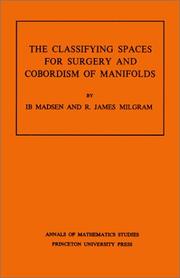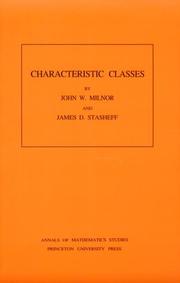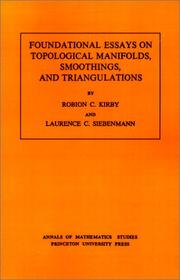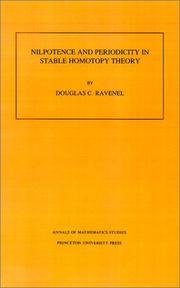| Listing 1 - 8 of 8 |
Sort by
|

ISBN: 0691082251 069108226X 1400881471 Year: 1979 Publisher: Princeton, N. J.
Abstract | Keywords | Export | Availability | Bookmark
 Loading...
Loading...Choose an application
- Reference Manager
- EndNote
- RefWorks (Direct export to RefWorks)
Beginning with a general discussion of bordism, Professors Madsen and Milgram present the homotopy theory of the surgery classifying spaces and the classifying spaces for the various required bundle theories. The next part covers more recent work on the maps between these spaces and the properties of the PL and Top characteristic classes, and includes integrality theorems for topological and PL manifolds. Later chapters treat the integral cohomology of BPL and Btop. The authors conclude with a discussion of the PL and topological cobordism rings and a construction of the torsion-free generators.
Algebraic topology --- 515.16 --- Classifying spaces --- Cobordism theory --- Manifolds (Mathematics) --- Surgery (Topology) --- Differential topology --- Homotopy equivalences --- Topology --- Geometry, Differential --- Spaces, Classifying --- Fiber bundles (Mathematics) --- Fiber spaces (Mathematics) --- Topology of manifolds --- Classifying spaces. --- Cobordism theory. --- Manifolds (Mathematics). --- Surgery (Topology). --- 515.16 Topology of manifolds --- Bijection. --- Calculation. --- Characteristic class. --- Classification theorem. --- Classifying space. --- Closed manifold. --- Cobordism. --- Coefficient. --- Cohomology. --- Commutative diagram. --- Commutative property. --- Complex projective space. --- Connected sum. --- Corollary. --- Cup product. --- Diagram (category theory). --- Differentiable manifold. --- Disjoint union. --- Disk (mathematics). --- Effective method. --- Eilenberg–Moore spectral sequence. --- Elaboration. --- Equivalence class. --- Exact sequence. --- Exterior algebra. --- Fiber bundle. --- Fibration. --- Function composition. --- H-space. --- Homeomorphism. --- Homomorphism. --- Homotopy fiber. --- Homotopy group. --- Homotopy. --- Hopf algebra. --- Iterative method. --- Loop space. --- Manifold. --- Massey product. --- N-sphere. --- Normal bundle. --- Obstruction theory. --- Pairing. --- Permutation. --- Piecewise linear manifold. --- Piecewise linear. --- Polynomial. --- Prime number. --- Projective space. --- Sequence. --- Simply connected space. --- Special case. --- Spin structure. --- Steenrod algebra. --- Subset. --- Summation. --- Tensor product. --- Theorem. --- Topological group. --- Topological manifold. --- Topology. --- Total order. --- Variétés topologiques --- Topologie differentielle
Book
ISBN: 0691189633 Year: 2019 Publisher: Princeton, NJ : Princeton University Press,
Abstract | Keywords | Export | Availability | Bookmark
 Loading...
Loading...Choose an application
- Reference Manager
- EndNote
- RefWorks (Direct export to RefWorks)
This book presents the complete proof of the Bloch-Kato conjecture and several related conjectures of Beilinson and Lichtenbaum in algebraic geometry. Brought together here for the first time, these conjectures describe the structure of étale cohomology and its relation to motivic cohomology and Chow groups.Although the proof relies on the work of several people, it is credited primarily to Vladimir Voevodsky. The authors draw on a multitude of published and unpublished sources to explain the large-scale structure of Voevodsky's proof and introduce the key figures behind its development. They go on to describe the highly innovative geometric constructions of Markus Rost, including the construction of norm varieties, which play a crucial role in the proof. The book then addresses symmetric powers of motives and motivic cohomology operations.Comprehensive and self-contained, The Norm Residue Theorem in Motivic Cohomology unites various components of the proof that until now were scattered across many sources of varying accessibility, often with differing hypotheses, definitions, and language.
Homology theory. --- Cohomology theory --- Contrahomology theory --- Algebraic topology --- 5P. --- Abelian group. --- Addition. --- Additive category. --- Adjoint functors. --- Alexander Grothendieck. --- Algebraic closure. --- Algebraic cobordism. --- Algebraic cycle. --- Algebraic extension. --- Algebraic geometry. --- Algebraic topology. --- Andrei Suslin. --- Axiom. --- Characteristic class. --- Classifying space. --- Closed set. --- Codimension. --- Cofibration. --- Cohomology operation. --- Cohomology. --- Conjecture. --- Corollary. --- Diagram (category theory). --- Direct limit. --- Exact sequence. --- Factorization. --- Fibration. --- Functor. --- Galois cohomology. --- Galois extension. --- Group object. --- Homology (mathematics). --- Homotopy category. --- Homotopy. --- Hypersurface. --- Inverse function. --- Mathematical induction. --- Mathematics. --- Milnor K-theory. --- Model category. --- Module (mathematics). --- Monoid. --- Monomorphism. --- Morphism. --- Motivic cohomology. --- Natural number. --- Normal bundle. --- Open set. --- Presheaf (category theory). --- Pushout (category theory). --- Quantity. --- Quillen adjunction. --- Rational point. --- Regular representation. --- Remainder. --- Retract. --- Separable extension. --- Sheaf (mathematics). --- Smooth scheme. --- Special case. --- Subgroup. --- Summation. --- Tangent space. --- Theorem. --- Trivial representation. --- Vladimir Voevodsky. --- Weak equivalence (homotopy theory).

ISBN: 0691081220 9780691081229 140088182X Year: 1974 Volume: 76 Publisher: Princeton (N.J.): Princeton university press,
Abstract | Keywords | Export | Availability | Bookmark
 Loading...
Loading...Choose an application
- Reference Manager
- EndNote
- RefWorks (Direct export to RefWorks)
The theory of characteristic classes provides a meeting ground for the various disciplines of differential topology, differential and algebraic geometry, cohomology, and fiber bundle theory. As such, it is a fundamental and an essential tool in the study of differentiable manifolds.In this volume, the authors provide a thorough introduction to characteristic classes, with detailed studies of Stiefel-Whitney classes, Chern classes, Pontrjagin classes, and the Euler class. Three appendices cover the basics of cohomology theory and the differential forms approach to characteristic classes, and provide an account of Bernoulli numbers.Based on lecture notes of John Milnor, which first appeared at Princeton University in 1957 and have been widely studied by graduate students of topology ever since, this published version has been completely revised and corrected.
Algebraic topology --- Characteristic classes --- Classes caractéristiques --- 515.16 --- #WWIS:d.d. Prof. L. Bouckaert/ALTO --- Classes, Characteristic --- Differential topology --- Topology of manifolds --- Characteristic classes. --- 515.16 Topology of manifolds --- Classes caractéristiques --- Additive group. --- Axiom. --- Basis (linear algebra). --- Boundary (topology). --- Bundle map. --- CW complex. --- Canonical map. --- Cap product. --- Cartesian product. --- Characteristic class. --- Charles Ehresmann. --- Chern class. --- Classifying space. --- Coefficient. --- Cohomology ring. --- Cohomology. --- Compact space. --- Complex dimension. --- Complex manifold. --- Complex vector bundle. --- Complexification. --- Computation. --- Conformal geometry. --- Continuous function. --- Coordinate space. --- Cross product. --- De Rham cohomology. --- Diffeomorphism. --- Differentiable manifold. --- Differential form. --- Differential operator. --- Dimension (vector space). --- Dimension. --- Direct sum. --- Directional derivative. --- Eilenberg–Steenrod axioms. --- Embedding. --- Equivalence class. --- Euler class. --- Euler number. --- Existence theorem. --- Existential quantification. --- Exterior (topology). --- Fiber bundle. --- Fundamental class. --- Fundamental group. --- General linear group. --- Grassmannian. --- Gysin sequence. --- Hausdorff space. --- Homeomorphism. --- Homology (mathematics). --- Homotopy. --- Identity element. --- Integer. --- Interior (topology). --- Isomorphism class. --- J-homomorphism. --- K-theory. --- Leibniz integral rule. --- Levi-Civita connection. --- Limit of a sequence. --- Linear map. --- Metric space. --- Natural number. --- Natural topology. --- Neighbourhood (mathematics). --- Normal bundle. --- Open set. --- Orthogonal complement. --- Orthogonal group. --- Orthonormal basis. --- Partition of unity. --- Permutation. --- Polynomial. --- Power series. --- Principal ideal domain. --- Projection (mathematics). --- Representation ring. --- Riemannian manifold. --- Sequence. --- Singular homology. --- Smoothness. --- Special case. --- Steenrod algebra. --- Stiefel–Whitney class. --- Subgroup. --- Subset. --- Symmetric function. --- Tangent bundle. --- Tensor product. --- Theorem. --- Thom space. --- Topological space. --- Topology. --- Unit disk. --- Unit vector. --- Variable (mathematics). --- Vector bundle. --- Vector space. --- Topologie differentielle --- Classes caracteristiques --- Classes et nombres caracteristiques

ISBN: 0691081905 0691081913 1400881501 9780691081908 Year: 1977 Volume: no. 88 Publisher: Princeton: Princeton university press,
Abstract | Keywords | Export | Availability | Bookmark
 Loading...
Loading...Choose an application
- Reference Manager
- EndNote
- RefWorks (Direct export to RefWorks)
Since Poincaré's time, topologists have been most concerned with three species of manifold. The most primitive of these--the TOP manifolds--remained rather mysterious until 1968, when Kirby discovered his now famous torus unfurling device. A period of rapid progress with TOP manifolds ensued, including, in 1969, Siebenmann's refutation of the Hauptvermutung and the Triangulation Conjecture. Here is the first connected account of Kirby's and Siebenmann's basic research in this area.The five sections of this book are introduced by three articles by the authors that initially appeared between 1968 and 1970. Appendices provide a full discussion of the classification of homotopy tori, including Casson's unpublished work and a consideration of periodicity in topological surgery.
Differential geometry. Global analysis --- Manifolds (Mathematics) --- Piecewise linear topology --- Triangulating manifolds --- Variétés (Mathématiques) --- Topologie linéaire par morceaux --- 515.16 --- Manifolds, Triangulating --- PL topology --- Topology --- Geometry, Differential --- Topology of manifolds --- Piecewise linear topology. --- Triangulating manifolds. --- Manifolds (Mathematics). --- 515.16 Topology of manifolds --- Variétés (Mathématiques) --- Topologie linéaire par morceaux --- Triangulation. --- Triangulation --- Affine space. --- Algebraic topology (object). --- Approximation. --- Associative property. --- Automorphism. --- Big O notation. --- CW complex. --- Calculation. --- Cap product. --- Cartesian product. --- Category of sets. --- Chain complex. --- Classification theorem. --- Classifying space. --- Cobordism. --- Codimension. --- Cofibration. --- Cohomology. --- Connected space. --- Continuous function (set theory). --- Continuous function. --- Counterexample. --- Diffeomorphism. --- Differentiable manifold. --- Differential structure. --- Differential topology. --- Dimension (vector space). --- Direct proof. --- Disjoint union. --- Elementary proof. --- Embedding. --- Euclidean space. --- Existence theorem. --- Existential quantification. --- Fiber bundle. --- Fibration. --- General position. --- Geometry. --- Group homomorphism. --- H-cobordism. --- H-space. --- Handle decomposition. --- Handlebody. --- Hauptvermutung. --- Hausdorff space. --- Hilbert cube. --- Homeomorphism group. --- Homeomorphism. --- Homomorphism. --- Homotopy group. --- Homotopy. --- Inclusion map. --- Injective function. --- Invertible matrix. --- K-cell (mathematics). --- Kan extension. --- Linear subspace. --- Linear topology. --- Manifold. --- Mapping cylinder. --- Mathematical induction. --- Mathematician. --- Metric space. --- Morse theory. --- Neighbourhood (mathematics). --- Open set. --- Partition of unity. --- Piecewise linear manifold. --- Piecewise linear. --- Poincaré conjecture. --- Polyhedron. --- Principal bundle. --- Product metric. --- Pushout (category theory). --- Regular homotopy. --- Retract. --- Sheaf (mathematics). --- Simplicial complex. --- Smoothing. --- Spin structure. --- Stability theory. --- Stable manifold. --- Standard map. --- Submanifold. --- Submersion (mathematics). --- Subset. --- Surgery exact sequence. --- Surjective function. --- Theorem. --- Topological group. --- Topological manifold. --- Topological space. --- Topology. --- Transversal (geometry). --- Transversality (mathematics). --- Transversality theorem. --- Union (set theory). --- Uniqueness theorem. --- Vector bundle. --- Zorn's lemma. --- Variétés topologiques

ISBN: 069108792X 069102572X 1400882486 9780691025728 9780691087924 Year: 1992 Volume: 128 Publisher: Princeton (N.J.): Princeton university press,
Abstract | Keywords | Export | Availability | Bookmark
 Loading...
Loading...Choose an application
- Reference Manager
- EndNote
- RefWorks (Direct export to RefWorks)
Nilpotence and Periodicity in Stable Homotopy Theory describes some major advances made in algebraic topology in recent years, centering on the nilpotence and periodicity theorems, which were conjectured by the author in 1977 and proved by Devinatz, Hopkins, and Smith in 1985. During the last ten years a number of significant advances have been made in homotopy theory, and this book fills a real need for an up-to-date text on that topic. Ravenel's first few chapters are written with a general mathematical audience in mind. They survey both the ideas that lead up to the theorems and their applications to homotopy theory. The book begins with some elementary concepts of homotopy theory that are needed to state the problem. This includes such notions as homotopy, homotopy equivalence, CW-complex, and suspension. Next the machinery of complex cobordism, Morava K-theory, and formal group laws in characteristic p are introduced. The latter portion of the book provides specialists with a coherent and rigorous account of the proofs. It includes hitherto unpublished material on the smash product and chromatic convergence theorems and on modular representations of the symmetric group.
Homotopie --- Homotopy theory --- Homotopy theory. --- Deformations, Continuous --- Topology --- Abelian category. --- Abelian group. --- Adams spectral sequence. --- Additive category. --- Affine space. --- Algebra homomorphism. --- Algebraic closure. --- Algebraic structure. --- Algebraic topology (object). --- Algebraic topology. --- Algebraic variety. --- Algebraically closed field. --- Atiyah–Hirzebruch spectral sequence. --- Automorphism. --- Boolean algebra (structure). --- CW complex. --- Canonical map. --- Cantor set. --- Category of topological spaces. --- Category theory. --- Classification theorem. --- Classifying space. --- Cohomology operation. --- Cohomology. --- Cokernel. --- Commutative algebra. --- Commutative ring. --- Complex projective space. --- Complex vector bundle. --- Computation. --- Conjecture. --- Conjugacy class. --- Continuous function. --- Contractible space. --- Coproduct. --- Differentiable manifold. --- Disjoint union. --- Division algebra. --- Equation. --- Explicit formulae (L-function). --- Functor. --- G-module. --- Groupoid. --- Homology (mathematics). --- Homomorphism. --- Homotopy category. --- Homotopy group. --- Homotopy. --- Hopf algebra. --- Hurewicz theorem. --- Inclusion map. --- Infinite product. --- Integer. --- Inverse limit. --- Irreducible representation. --- Isomorphism class. --- K-theory. --- Loop space. --- Mapping cone (homological algebra). --- Mathematical induction. --- Modular representation theory. --- Module (mathematics). --- Monomorphism. --- Moore space. --- Morava K-theory. --- Morphism. --- N-sphere. --- Noetherian ring. --- Noetherian. --- Noncommutative ring. --- Number theory. --- P-adic number. --- Piecewise linear manifold. --- Polynomial ring. --- Polynomial. --- Power series. --- Prime number. --- Principal ideal domain. --- Profinite group. --- Reduced homology. --- Ring (mathematics). --- Ring homomorphism. --- Ring spectrum. --- Simplicial complex. --- Simply connected space. --- Smash product. --- Special case. --- Spectral sequence. --- Steenrod algebra. --- Sub"ient. --- Subalgebra. --- Subcategory. --- Subring. --- Symmetric group. --- Tensor product. --- Theorem. --- Topological space. --- Topology. --- Vector bundle. --- Zariski topology.
Book
ISBN: 0691138214 1400837111 0691138222 9780691138220 9781400837113 9780691138213 Year: 2009 Publisher: Princeton, N.J. Princeton University Press
Abstract | Keywords | Export | Availability | Bookmark
 Loading...
Loading...Choose an application
- Reference Manager
- EndNote
- RefWorks (Direct export to RefWorks)
In 1970, Phillip Griffiths envisioned that points at infinity could be added to the classifying space D of polarized Hodge structures. In this book, Kazuya Kato and Sampei Usui realize this dream by creating a logarithmic Hodge theory. They use the logarithmic structures begun by Fontaine-Illusie to revive nilpotent orbits as a logarithmic Hodge structure. The book focuses on two principal topics. First, Kato and Usui construct the fine moduli space of polarized logarithmic Hodge structures with additional structures. Even for a Hermitian symmetric domain D, the present theory is a refinement of the toroidal compactifications by Mumford et al. For general D, fine moduli spaces may have slits caused by Griffiths transversality at the boundary and be no longer locally compact. Second, Kato and Usui construct eight enlargements of D and describe their relations by a fundamental diagram, where four of these enlargements live in the Hodge theoretic area and the other four live in the algebra-group theoretic area. These two areas are connected by a continuous map given by the SL(2)-orbit theorem of Cattani-Kaplan-Schmid. This diagram is used for the construction in the first topic.
Hodge theory. --- Logarithms. --- Logs (Logarithms) --- Algebra --- Complex manifolds --- Differentiable manifolds --- Geometry, Algebraic --- Homology theory --- Algebraic group. --- Algebraic variety. --- Analytic manifold. --- Analytic space. --- Annulus (mathematics). --- Arithmetic group. --- Atlas (topology). --- Canonical map. --- Classifying space. --- Coefficient. --- Cohomology. --- Compactification (mathematics). --- Complex manifold. --- Complex number. --- Congruence subgroup. --- Conjecture. --- Connected component (graph theory). --- Continuous function. --- Convex cone. --- Degeneracy (mathematics). --- Diagram (category theory). --- Differential form. --- Direct image functor. --- Divisor. --- Elliptic curve. --- Equivalence class. --- Existential quantification. --- Finite set. --- Functor. --- Geometry. --- Hodge structure. --- Homeomorphism. --- Homomorphism. --- Inverse function. --- Iwasawa decomposition. --- Local homeomorphism. --- Local ring. --- Local system. --- Logarithmic. --- Maximal compact subgroup. --- Modular curve. --- Modular form. --- Moduli space. --- Monodromy. --- Monoid. --- Morphism. --- Natural number. --- Nilpotent orbit. --- Nilpotent. --- Open problem. --- Open set. --- P-adic Hodge theory. --- P-adic number. --- Point at infinity. --- Proper morphism. --- Pullback (category theory). --- Quotient space (topology). --- Rational number. --- Relative interior. --- Ring (mathematics). --- Ring homomorphism. --- Scientific notation. --- Set (mathematics). --- Sheaf (mathematics). --- Smooth morphism. --- Special case. --- Strong topology. --- Subgroup. --- Subobject. --- Subset. --- Surjective function. --- Tangent bundle. --- Taylor series. --- Theorem. --- Topological space. --- Topology. --- Transversality (mathematics). --- Two-dimensional space. --- Vector bundle. --- Vector space. --- Weak topology.
Book
ISBN: 1283227436 9786613227430 1400839041 9781400839049 9781283227438 9780691147949 0691147949 Year: 2012 Publisher: Princeton, N.J. : Princeton University Press,
Abstract | Keywords | Export | Availability | Bookmark
 Loading...
Loading...Choose an application
- Reference Manager
- EndNote
- RefWorks (Direct export to RefWorks)
"The study of the mapping class group Mod(S) is a classical topic that is experiencing a renaissance. It lies at the juncture of geometry, topology, and group theory. This book explains as many important theorems, examples, and techniques as possible, quickly and directly, while at the same time giving full details and keeping the text nearly self-contained. The book is suitable for graduate students.The book begins by explaining the main group-theoretical properties of Mod(S), from finite generation by Dehn twists and low-dimensional homology to the Dehn-Nielsen-Baer theorem. Along the way, central objects and tools are introduced, such as the Birman exact sequence, the complex of curves, the braid group, the symplectic representation, and the Torelli group. The book then introduces Teichm©oller space and its geometry, and uses the action of Mod(S) on it to prove the Nielsen-Thurston classification of surface homeomorphisms. Topics include the topology of the moduli space of Riemann surfaces, the connection with surface bundles, pseudo-Anosov theory, and Thurston's approach to the classification"--Provided by publisher.
Mappings (Mathematics) --- Class groups (Mathematics) --- Groups, Class (Mathematics) --- Algebraic number theory --- Commutative rings --- Ideals (Algebra) --- Maps (Mathematics) --- Functions --- Functions, Continuous --- Topology --- Transformations (Mathematics) --- 3-manifold theory. --- Alexander method. --- Birman exact sequence. --- BirmanЈilden theorem. --- Dehn twists. --- DehnЌickorish theorem. --- DehnЎielsenЂaer theorem. --- Dennis Johnson. --- Euler class. --- FenchelЎielsen coordinates. --- Gervais presentation. --- Grtzsch's problem. --- Johnson homomorphism. --- Markov partitions. --- Meyer signature cocycle. --- Mod(S). --- Nielsen realization theorem. --- NielsenДhurston classification theorem. --- NielsenДhurston classification. --- Riemann surface. --- Teichmller mapping. --- Teichmller metric. --- Teichmller space. --- Thurston compactification. --- Torelli group. --- Wajnryb presentation. --- algebraic integers. --- algebraic intersection number. --- algebraic relations. --- algebraic structure. --- annulus. --- aspherical manifold. --- bigon criterion. --- braid group. --- branched cover. --- capping homomorphism. --- classifying space. --- closed surface. --- collar lemma. --- compactness criterion. --- complex of curves. --- configuration space. --- conjugacy class. --- coordinates principle. --- cutting homomorphism. --- cyclic subgroup. --- diffeomorphism. --- disk. --- existence theorem. --- extended mapping class group. --- finite index. --- finite subgroup. --- finite-order homeomorphism. --- finite-order mapping class. --- first homology group. --- geodesic laminations. --- geometric classification. --- geometric group theory. --- geometric intersection number. --- geometric operation. --- geometry. --- harmonic maps. --- holomorphic quadratic differential. --- homeomorphism. --- homological criterion. --- homotopy. --- hyperbolic geometry. --- hyperbolic plane. --- hyperbolic structure. --- hyperbolic surface. --- inclusion homomorphism. --- infinity. --- intersection number. --- isotopy. --- lantern relation. --- low-dimensional homology. --- mapping class group. --- mapping torus. --- measured foliation space. --- measured foliations. --- metric geometry. --- moduli space. --- orbifold. --- orbit. --- outer automorphism group. --- pseudo-Anosov homeomorphism. --- punctured disk. --- quasi-isometry. --- quasiconformal map. --- second homology group. --- simple closed curve. --- simplicial complex. --- stretch factors. --- surface bundles. --- surface homeomorphism. --- surface. --- symplectic representation. --- topology. --- torsion. --- torus. --- train track.
Book
ISBN: 0691197482 Year: 2021 Publisher: Princeton : Princeton University Press,
Abstract | Keywords | Export | Availability | Bookmark
 Loading...
Loading...Choose an application
- Reference Manager
- EndNote
- RefWorks (Direct export to RefWorks)
This volume gives a clear introductory account of equivariant cohomology, a central topic in algebraic topology. Assuming readers have taken one semester of manifold theory and a year of algebraic topology, Loring Tu begins with the topological construction of equivariant cohomology, then develops the theory for smooth manifolds with the aid of differential forms. To keep the exposition simple, the equivariant localisation theorem is proven only for a circle action. An appendix gives a proof of the equivariant de Rham theorem, demonstrating that equivariant cohomology can be computed using equivariant differential forms. Examples and calculations illustrate new concepts. Exercises include hints or solutions, making this book suitable for self-study.
Cohomology operations. --- Operations (Algebraic topology) --- Algebraic topology --- Algebraic structure. --- Algebraic topology (object). --- Algebraic topology. --- Algebraic variety. --- Basis (linear algebra). --- Boundary (topology). --- CW complex. --- Cellular approximation theorem. --- Characteristic class. --- Classifying space. --- Coefficient. --- Cohomology ring. --- Cohomology. --- Comparison theorem. --- Complex projective space. --- Continuous function. --- Contractible space. --- Cramer's rule. --- Curvature form. --- De Rham cohomology. --- Diagram (category theory). --- Diffeomorphism. --- Differentiable manifold. --- Differential form. --- Differential geometry. --- Dual basis. --- Equivariant K-theory. --- Equivariant cohomology. --- Equivariant map. --- Euler characteristic. --- Euler class. --- Exponential function. --- Exponential map (Lie theory). --- Exponentiation. --- Exterior algebra. --- Exterior derivative. --- Fiber bundle. --- Fixed point (mathematics). --- Frame bundle. --- Fundamental group. --- Fundamental vector field. --- Group action. --- Group homomorphism. --- Group theory. --- Haar measure. --- Homotopy group. --- Homotopy. --- Hopf fibration. --- Identity element. --- Inclusion map. --- Integral curve. --- Invariant subspace. --- K-theory. --- Lie algebra. --- Lie derivative. --- Lie group action. --- Lie group. --- Lie theory. --- Linear algebra. --- Linear function. --- Local diffeomorphism. --- Manifold. --- Mathematics. --- Matrix group. --- Mayer–Vietoris sequence. --- Module (mathematics). --- Morphism. --- Neighbourhood (mathematics). --- Orthogonal group. --- Oscillatory integral. --- Principal bundle. --- Principal ideal domain. --- Quotient group. --- Quotient space (topology). --- Raoul Bott. --- Representation theory. --- Ring (mathematics). --- Singular homology. --- Spectral sequence. --- Stationary phase approximation. --- Structure constants. --- Sub"ient. --- Subcategory. --- Subgroup. --- Submanifold. --- Submersion (mathematics). --- Symplectic manifold. --- Symplectic vector space. --- Tangent bundle. --- Tangent space. --- Theorem. --- Topological group. --- Topological space. --- Topology. --- Unit sphere. --- Unitary group. --- Universal bundle. --- Vector bundle. --- Vector space. --- Weyl group.
| Listing 1 - 8 of 8 |
Sort by
|

 Search
Search Feedback
Feedback About UniCat
About UniCat  Help
Help News
News